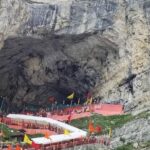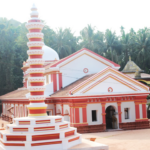Baidyanath Jyotirlinga (also known as Vaidyanath Jyotirlinga) is one of the twelve sacred Jyotirlingas of Lord Shiva. It is located in Deoghar, in the Jharkhand state of India. This temple is highly revered by devotees, who believe that worshipping the Baidyanath Jyotirlinga can bring healing, prosperity, and liberation (moksha).
Mythological Significance:
The Baidyanath Jyotirlinga is associated with a powerful legend that connects it to the demon king Ravana:
- Ravana’s Devotion: Ravana, the mighty king of Lanka, was a devoted worshipper of Lord Shiva. In his quest for power and invincibility, Ravana performed intense penance to please Lord Shiva and sought his blessings. As part of his penance, Ravana is said to have offered his ten heads one by one as a sacrifice to Shiva. Moved by Ravana’s devotion, Lord Shiva appeared before him and granted him immense power, along with the Atma Lingam (a form of the Jyotirlinga).
- Ravana’s Journey to Lanka: Ravana requested Lord Shiva to accompany him to Lanka, but Lord Shiva instead gave him the Atma Lingam, warning him that it should not be placed on the ground until it reached Lanka. If the Lingam was placed on the ground, it would remain fixed in that spot forever.
- Deception by the Gods: The gods, fearing Ravana’s strength and the consequences of the Lingam being established in Lanka, devised a plan to stop him. While Ravana was traveling with the Lingam, Lord Vishnu created an illusion, causing Ravana to feel the need to perform his evening prayers. During this time, Lord Ganesha, disguised as a young boy, appeared before Ravana. Ravana asked the boy to hold the Lingam while he completed his prayers, but Ganesha placed the Lingam on the ground. As soon as the Lingam touched the ground, it became immovable.
- Establishment of Baidyanath Jyotirlinga: Despite Ravana’s best efforts, the Lingam could not be moved. Lord Shiva appeared and declared that the Lingam would remain in that spot, becoming the Baidyanath Jyotirlinga. Although Ravana could not take the Lingam to Lanka, he continued to worship it, and the Baidyanath temple became a site of pilgrimage.
- Lord Shiva as Vaidya (Healer): Another interpretation of the name “Baidyanath” comes from the belief that Lord Shiva acted as a vaidya (healer or physician) when he cured Ravana of his injuries after the intense penance and offering of his heads. Hence, Shiva came to be known as Vaidyanath, the Lord of Healing.
Historical and Spiritual Importance:
- The Baidyanath Jyotirlinga is considered a powerful source of healing and divine energy. Many devotees believe that worshipping at this shrine can cure them of diseases and alleviate suffering.
- The temple complex is also home to other smaller shrines, and it attracts a large number of pilgrims, especially during the holy month of Shravan (July–August), when the Kanwar Yatra takes place. Devotees, known as Kanwariyas, walk long distances carrying holy water from the Ganges River to offer at the Baidyanath Jyotirlinga.
Temple Architecture:
- The Baidyanath Temple has a simple yet impressive architectural style. The main temple is built in the Nagara style, characterized by a tall shikhara (tower) over the sanctum. The Lingam inside the temple is set within a sanctum that is open to devotees for Abhishekam (ritual bathing) and prayers.
- The temple complex also includes smaller shrines dedicated to various deities, including Parvati, Ganesha, and Vishnu.
Rituals and Festivals:
- Shravan Mela: The month of Shravan is the most significant time for worship at Baidyanath. Devotees undertake the Kanwar Yatra, carrying water from the Ganges to offer to Lord Shiva at the temple. The temple sees a massive influx of devotees during this time.
- Maha Shivaratri: The festival of Maha Shivaratri is another important event, where devotees fast and stay awake throughout the night to offer prayers and seek Lord Shiva’s blessings.
- Daily Rituals: The daily worship includes Abhishekam, where devotees pour water and milk over the Lingam. Special pujas and rituals are performed by the temple priests to honor Lord Shiva.
Spiritual Beliefs:
- The Baidyanath Jyotirlinga is believed to have immense healing powers. Worshipping Lord Shiva here is said to cure diseases and provide relief from physical and mental ailments.
- Devotees also believe that offering prayers at the Baidyanath Jyotirlinga with true devotion can lead to the fulfillment of desires, prosperity, and moksha (spiritual liberation).
How to Reach:
- Deoghar is well connected by road and rail to major cities like Ranchi, Patna, and Kolkata. The nearest major railway station is Jasidih Junction, about 8 km from the temple. The nearest airport is Deoghar Airport, which recently became operational and offers connectivity to major cities.
- The temple is located in a serene and spiritual environment, with devotees often walking barefoot through the streets of Deoghar to reach the temple.
Conclusion:
The Baidyanath Jyotirlinga in Deoghar is a sacred place for millions of devotees, drawing people from all over India and beyond for its spiritual and healing powers. With its deep-rooted connection to the legend of Ravana and its association with Lord Shiva as the divine physician, it remains one of the most important pilgrimage destinations for those seeking spiritual solace, healing, and liberation.













